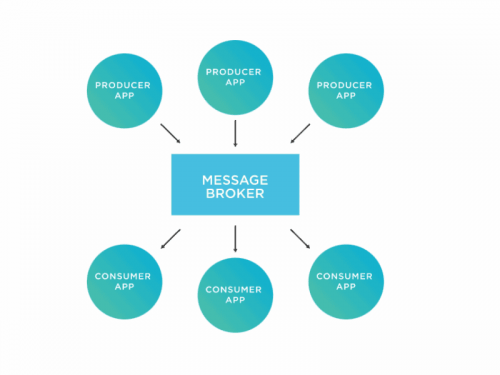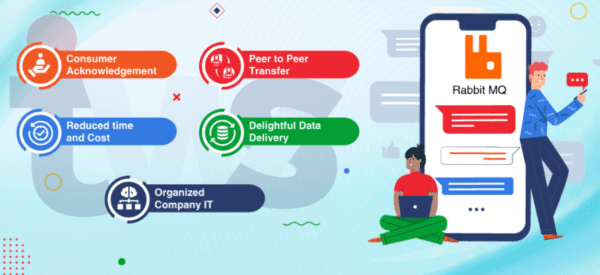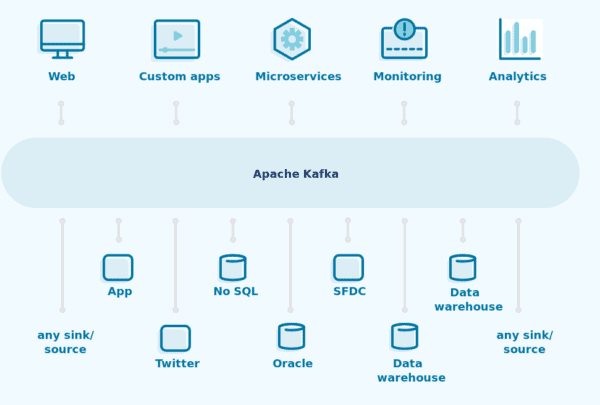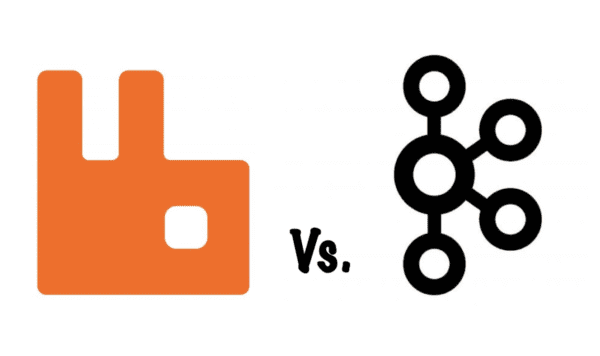RabbitMQ vs Kafka – Message Brokers (Pros and Cons)
RabbitMQ vs Kafka – Message Brokers (Pros and Cons). In this article I will introduce what a message broker is and then move onto an introduction of RabbitMQ with its pros and cons and after that will introduce Kafka with it’s pros and cons and them compare both solutions.
What is a message Broker
The communication system around the globe has been evolving, from telephone calls to virtual messages. The technology is upgrading into new levels constantly. It does that by modifying each complex job into more feasible and convenient routes to communicate. Now you can quickly validate, save and send messages to the exact location through the Message Broker mechanism.
The message broker is an architectonic pattern used in configuring, routing, saving, delivering messages between applications, systems and services, whether the receiver is online/available or not. The message broker waits for the receiver to come online in order to deliver the message. Different languages or platforms are not a problem to communication. In addition we can use message brokers to build a Weka machine learning and artificial intelligence machine among applications.
Rabbit MQ and Kafka are providing excellent services being a part of message broker tools. RabbitMQ is known for its efficiency and minimum traffic, while Kafka effortlessly handles a massive pile of data. Therefore, we are going to discuss both tools in multiple aspects, which will assist you in picking the right software for your project.
RabbitMQ vs Kafka – Message Brokers (Pros and Cons)? Firstly I will introduce what RabbitMQ is below.
What is RabbitMQ
RabbitMQ is an open source software that offers a message broker facility based on the Mozilla license. Users use it for sending messages between applications and systems. Also, it contains an inherited feature called Exchange Type, which allows routing messages before sending them to the queue. Moreover, it enables users to bind exchanges together or write the exchange type as a plugin for the multiplex routing.
In addition RabbitMQ server is based on Advanced Messaging Queuing Protocol (AMQP). Message Queuing does not have any innate feature of dispatching and collecting messages, but it has the ability to connect multiple applications. The message queue requires three elements to commence a process; a producer, a consumer and a broker. The producer’s role is to produce a message and send it to the broker, who keeps the message and forward it to the consumer when it comes online.
Pros of RabbitMQ
- It is single broker solution, which makes it efficient.
- Custom plug-ins (Java).
- Clustering.
- Exchanged types: Direct exchange, Topic, Fanout and Headers exchange.
- Prevents the loss of the messages by providing delivery acknowledgments.
- It gives you with various routing patterns to dispatch a message.
- As being open source, it is accessible to everyone.
- Send messages to suitable consumers and queues.
- It has minimum traffic.
- The configuration system is efficient.
- It contains two authentication machines and good backend authorization, making it double secure.
- One million messages can be scaled in one second by using RabbitMQ.
- It provides password based authentication.
Cons of RabbitMQ
- Slow at processing large datasets.
- Quite tricky at maintaining.
- It has premium integration services.
- Limited range of brokers as it is a single broker based.
- Poor documentation.
What is Kafka
Apache Kafka is an open source framework created by Apache with a license of Apache License 2.0. It is used to create a real time streaming, data pipeline and streaming data applications, that assist in traveling the streams of data from one end to another. A data pipeline is used to travel data from one system to another and a streaming data application is used to consume streams of data. Data streams manage a flood of data and produce data sources in thousands.
Kafka server is a message broker platform to build a communication medium between applications using a partitioned log model. Kafka is an event streaming platform Queuing enables data processing to be dispersed to multiple consumers, and publish subscribe implements the multi subscriber approach.
Interestingly in Kafka, the log is an ordered arrangement of records that are disintegrated into a unit correlated to separate subscribers. Furthermore, it renders three main features to its users; it enables users to subscribe or publish the streams of record, save the streams of history and operate streams of record in real time.
RabbitMQ vs Kafka – Message Brokers (Pros and Cons). Next I shall introduce what Apache Kafka is.
Pros of Kafka
- Kafka can manage messages with a low latency range of milliseconds.
- It can prevent error through its inborn ability of being Fault Tolerant.
- Acts as a buffer.
- Reduces the need for multiple integrations.
- Kafka interface integrates with event sources like Postgres, JMS or Elasticsearch.
- It stores messages so you won’t misplace messages (keep copies of the messages).
- Scalability as large datasets are quickly processed and managed by Kafka (thousands of messages can be processed per second).
- It is adaptive because it acts uniquely according to the consumers, making it more amiable to the users.
- Real Time handling and real time data pipeline.
- Batch approach.
Cons of Kafka
- Lack of monitoring tools.
- New Brokers can impact the performance.
- Doesn’t embrace wildcard topic selection that disables addressing certain use cases.
- Constraint messaging patterns do not support request, reply and point to point queues.
- Sometimes it gets slow when the range of Kafka clusters is enhanced.
- The performance is decreased when the compressed messages by the consumer and broker are decompressed.
RabbitMQ vs Kafka Message Brokers
Here is in detail comparison of both RabbitMQ vs Kafka message brokers.
RabbitMQ vs Kafka
Below are the significant differences between RabbitMQ and Kafka:
- Performance: RabbitMQ can process four thousand to ten thousand messages per second. Whereas Kafka can process one million messages per second which makes the performance of Kafka is faster than RabbitMQ.
- Topology: RabbitMQ is Exchange queue topology based, in which your messages are sent to exchange after they are forwarded to different queues binding for the utilization of the consumers. Kafka is a publish subscribe topology based, in which your messages are sent in the form of streams after they are forwarded to the users through various authorized groups.
- Messaging Pattern: RabbitMQ deletes the messages from queues when they are delivered and acknowledged. On the other hand, Kafka retains a record of the messages until its expiratory date and saves the messages in the queues.
- Model: RabbitMQ implements Smartbroker/DumbConsumer model. The broker persistently emits the messages to the consumer while keeping a log of their status. In opposition Kafka implements Dumbbroker/SmartConsumer model that does not hold the record but keeps the unseen messages for a particular time.
- Data Transmission: RabbitMQ uses bounded data flow, in which the producer writes or sends the messages and the consumer receives the messages. To the contrary, Kafka uses unbounded data flow in which a key value pair is streamed to the appointed topic without a pause.
- Payload Size: RabbitMQ contains an infinite size of the payload, which provides you with greater capacity to transmit your data but contrastingly in Kafka, it holds a one megabyte default payload size.
- Use Cases: RabbitMQ is based on simple use cases but on the other hand Kafka is based on massive data or high throughput cases.
- Asynchronous Messaging Paradigm: RabbitMQ and Kafka both follow the asynchronous messaging paradigm to send messages from producer to consumer applications. However, it does not require the producer or consumer at the same time to be online together.
- Pull or Push Approach: RabbitMQ uses a push approach. The push approach ensures that the messages must be parallelized even and processed when dispatched to the queues. In contrary Kafka uses a pull approach, enabling consumers to seize messages/data from the topic.
RabbitMQ vs Kafka – Message Brokers Conclusion
RabbitMQ and Kafka’s tools serve their best in their specific ways, features and capabilities. They are both easily accessible and provide you with a lot of of services that attract users’ requirements. RabbitMQ manages its messages through a giant Rabbit cluster that contains thirty plus nodes, while Kafka uses sequential disk I/O operations, which minimizes the need for the hardware.
It usually depends on of your needs as the user and what task you are performing. Therefore, for your convenience and to make your work more efficient, we detailed our comparison of RabbitMQ and Kafka so you can easily choose a preferable framework for your machine.
Related Posts:
- RabbitMQ vs Redis - Message Brokers (Pros and Cons)
- Top 15 Best RabbitMQ Alternatives Message Brokers (Pros and Cons)
- Kafka Best Practices-Topic, Partitions, Consumers, Producers and Brokers
- How to Install Apache Kafka on CentOS Stream 8 (Linux Message Broker)
- How to Install Apache Kafka on Debian 11 (Linux Message Broker)
- How to Install Apache Kafka on Ubuntu 20.04 (Kafka Cluster)





